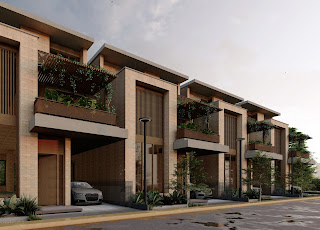Why Sustainable Living is the Future of Urban Development
The rapid urbanization and industrialization in recent years
have led to unprecedented levels of pollution and environmental degradation.
This has caused a significant impact on our health and wellbeing. In response,
sustainable living has emerged as a critical solution for the future of urban
development. Sustainable living practices, such as eco-friendly homes, green
spaces, and eco-friendly transportation, can help reduce our carbon footprint
and create a healthier and more sustainable urban environment.
One great example of sustainable living is the Svasthya
Mandala project, an eco-friendly gated community in Whitefield, Bangalore. The project aims to
create a sustainable living environment that promotes health and wellbeing. The
community features eco-friendly homes, green spaces, and an emphasis on
sustainable transportation. The project also emphasizes the use of natural
materials and renewable energy sources to reduce energy consumption and promote
sustainability.
Eco-friendly homes are a significant aspect of sustainable
living, especially in urban areas. These homes are designed to minimize their
impact on the environment and promote energy efficiency. They incorporate
features like solar panels, rainwater harvesting systems, and energy-efficient
appliances to reduce energy consumption and promote sustainability. These homes
also use materials like bamboo, recycled wood, and natural stone, which are
more sustainable and less damaging to the environment than traditional building
materials.
The Svasthya Mandala project features eco-friendly homes that
incorporate these sustainable living practices. These homes are designed to be
energy-efficient, and they utilize renewable energy sources like solar power to
reduce their carbon footprint. They also incorporate rainwater harvesting
systems to reduce water consumption and promote sustainability.
Another aspect of sustainable living is the creation of green
spaces. Green spaces help to reduce air pollution, provide a space for exercise
and relaxation, and improve overall health and wellbeing. The Eco friendly homes in Bangalore project features extensive green
spaces that include parks, gardens, and a central courtyard. These green spaces
are designed to promote biodiversity and provide a sanctuary for wildlife in
the midst of urban development.
A crucial component of living sustainably is sustainable
mobility. In many urban areas, transportation is a significant contributor to
air pollution and environmental degradation. Sustainable transportation
options, such as electric cars, bicycles, and public transportation, can help
reduce our carbon footprint and promote sustainability.
The Svasthya Mandala project also emphasizes sustainable
transportation options. The community features dedicated bicycle lanes and
pedestrian walkways to promote sustainable transportation. The project also
includes electric charging stations for electric cars, promoting the use of
sustainable transportation options.
Sustainable living practices like those showcased in the
Svasthya Mandala project are not only beneficial for the environment but also
promote overall health and wellbeing. The community emphasizes the use of
natural materials and renewable energy sources, reducing the risk of toxic
materials and air pollution. The green spaces and sustainable transportation
options also promote physical activity and reduce the risk of chronic diseases
like obesity and heart disease.
In addition to eco-friendly homes and green spaces,
sustainable living also encompasses sustainable food production and waste
management practices. Sustainable food production promotes the use of local and
organic food, reducing the carbon footprint associated with transportation and
production. Sustainable waste management practices, such as composting and
recycling, can also reduce the amount of waste that ends up in landfills,
reducing environmental pollution and promoting sustainability.
Sustainable living is the future of urban development, and
the Svasthya Mandala project is an excellent example of how sustainable living
practices can be incorporated into urban development. Eco-friendly homes, green
spaces, sustainable transportation options, sustainable food production, and
waste management practices are all critical components of sustainable living.
The Villas in Bellandur is another excellent example of
sustainable living in Bangalore. The community features eco-friendly homes
designed to promote energy efficiency and sustainability. The Villas in Bellandur also features extensive green spaces, including a
community garden and park, promoting biodiversity and providing a sanctuary for
wildlife in the midst of urban development.


.gif)

Comments
Post a Comment